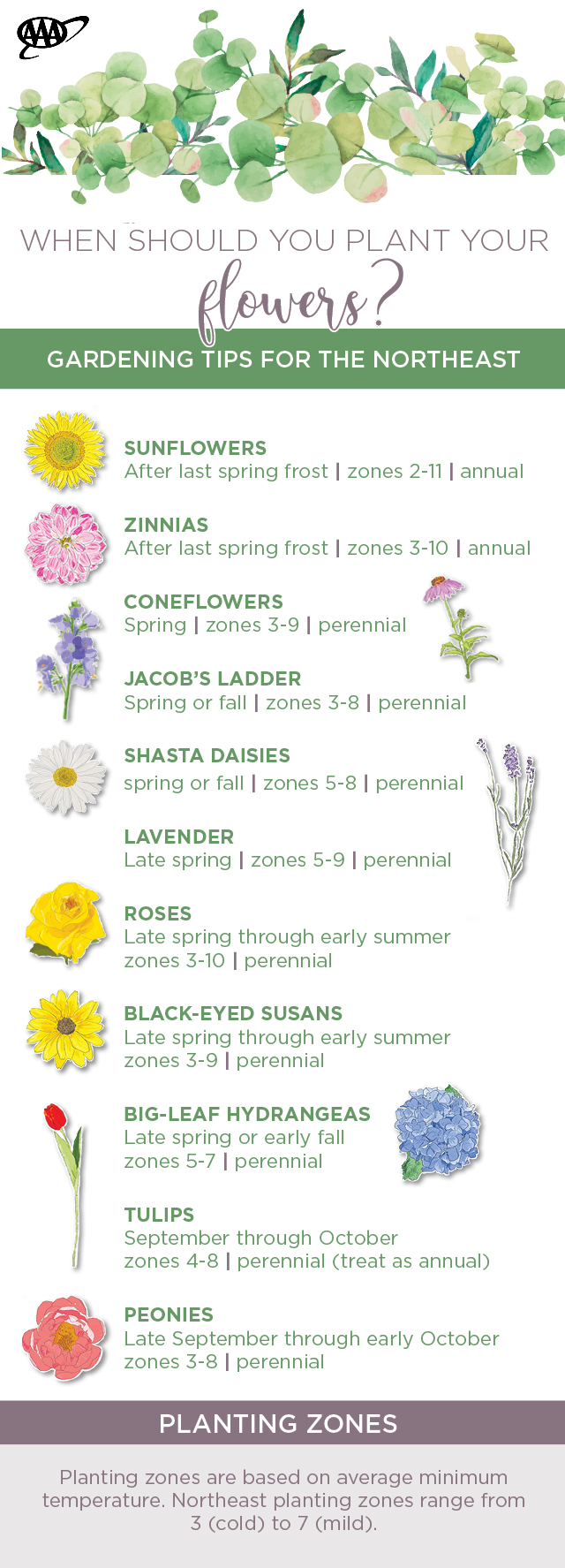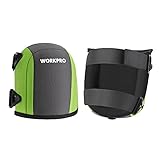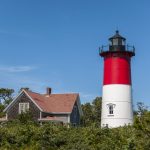Gardening is one of the most satisfying pastimes. You dig around in the dirt a little bit, apply water and then – voila! – you have vegetables, greenery and flowers. Whether it’s spring, summer or fall, flowers can brighten up your garden or landscaping. But when is the best time to plant flowers? Our Northeast flower chart can help.
One of the first things you need to know when planting flowers is your planting zone. For the uninitiated, a planting zone is a way of measuring climate differences. The zones are based on the average annual minimum temperature in that area. You can find your zone here. There are around 11 planting zones in the US. Northeast planting zones range from 3 (cold) to 7 (mild), though most of the Northeast sits comfortably between zones 5 and 6. Only the very upper regions of New York, New Hampshire, Vermont and Maine get into the 3-4 range.
Sourced from the Old Farmer’s Almanac, our flower chart marks the zones in which certain flowers flourish, and it also notes if they’re annuals or perennials. Annual flowers, like impatiens, go through their entire life cycle in one planting period. If you want impatiens every spring, you have to plant them every spring. Perennial flowers, like peonies, have a longer life cycle. With proper care, they can return and flower year after year.
An important thing to note when consulting our flower chart is that most flowers do not do well in extremes. As you look over the flower chart, you’ll notice that almost all of the flowers thrive best when planted in either spring or fall. These mild, in-between seasons are perfect for growing strong and healthy flowering plants. Everyone knows you can’t usually plant flowers in winter, but the dog days of summer can be just as bad.
Need new gardening tools and supplies? Shop our Amazon storefront.

Sunflowers
Sunflowers are annual flowers that flourish in zones 2-11. (Although there are some smaller perennial varieties.) It is best to plant them after the last spring frost. Sunflowers look almost like huge daisies – some of them can grow over 16 feet in height! They are hardy plants that are easy to maintain. Sunflowers bloom in summer and early fall.
Zinnias
These annual plants grow best in zones 3-10. Like sunflowers, make sure to plant them after the last spring frost, and no sooner. Zinnias are great flowers for new gardeners, since they’re easy to plant as seeds and they grow very quickly. They bloom in summer and are beloved by butterflies.
Coneflowers
Coneflowers are perennials that grow in zones 3-9. These spindly purple flowers are best when planted in spring. Coneflowers bloom from June to October, adding a vibrant pop of color to your garden for many months. Like zinnias, they also attract butterflies.
Jacob’s Ladder
This perennial plant can grow in zones 3-8, and can be planted in either spring or fall. The vibrant purple flowers can bloom from late spring to early summer, and last up to four weeks.
Shasta Daisies
Shasta daisies are perennial flowers that can grow in zones 5-8. Like Jacob’s ladder, they can be planted in spring or fall. These flowers are classics of the garden, with white petals and yellow florets. Shasta daisies bloom in spring or early summer, and sometimes even flower through fall.
Lavender
This fragrant perennial grows in zones 5-9, and should be planted in late spring. Expect the signature fragrance to hit its peak when they bloom in late spring and early summer.
Roses
Roses are perennial flowers that can grow in zones 3-10. Plant your roses in late spring or early summer. There are many different types of roses, but they usually bloom on and off from spring to fall.
Black-Eyed Susans
These perennials thrive in zones 3-9. They should be planted in late spring or early summer, when the soil temperature reaches 70 degrees. Black-eyed susans brighten up any garden when they bloom throughout the summer.
Big-Leaf Hydrangeas
Big-leaf hydrangeas are perennial and they grow in zones 5-7. They can be planted in either spring or fall. Big-leaf hydrangeas are fascinating flowers that grow in an array of rich colors depending on the pH level of the soil. My hydrangeas blooms in shades of blue, purple and pink, so I truly have no idea what’s going on in my dirt. They bloom from mid-spring to early fall.
Tulips
Tulips are technically perennial, but generations of hybridization and human meddling has weakened their ability to come back year after year. Most gardeners treat them as annuals. Tulips can grow in zones 4-8. They should be planted in the fall, about 6-8 weeks before hard frost sets in. Tulips come in many varieties, but they usually bloom in spring.
Peonies
Peonies are perennial flowers that do best in zones 3-8. They are best planted from late September to early October, about six weeks before the ground freezes. These fat, fragrant blossoms flourish when planted in an area with direct sunlight. Once established, peony bushes are hardy plants with vast root systems. They bloom in late spring and early summer.
| Garden Gadgets You Need | ||||
|---|---|---|---|---|
 Top
Top | Garden Tools Set | Gardening Gifts | Gardening Tools Set | 9 Piece Garden Tool Set | Digging Claw Gardening Gloves Succulent Tool Set | Planting Tools | Gardening Supplies Basket | Rake Gloves | PrimeEligible | Buy Now | |
 Top
Top | Garden Tool Set, CHRYZTAL Stainless Steel Heavy Duty Gardening Tool Set, with Non-Slip Rubber Grip, Storage Tote Bag, Outdoor Hand Tools, Ideal Garden Tool Kit Gifts for Women and Men | PrimeEligible | Buy Now | |
 Top
Top | NISAKU NJP650 The Original Hori Hori Namibagata Japanese Stainless Steel Weeding Knife, 7.25-Inch Blade | PrimeEligible | Buy Now | |
 Top
Top | Vita Gardens 4x4 Garden Bed with Grow Grid, Packaging may vary | PrimeEligible | Buy Now | |
 Top
Top | MIXC Raised Garden Bed with Legs, Metal Elevated Outdoor Planter Box for Backyard & Patio, Large Planter for Outdoor Plants,Black | PrimeEligible | Buy Now | |
 | Planters' Choice Indoor Plant Moisture Meter Soil Tester - No Batteries Required : Water Sensor Hydrometer for Plants : Houseplant Care - Gardening Tools - Planting Accessories | PrimeEligible | Buy Now | |
 | OFFIDIX Glass Plant Mister, 6.3 Inches Tall Vintage Style Spritzer Bronze Plastic Top Pump One Hand Watering Can Indoor Plant Spray Bottle for Garden, Plants, Cleaning (Dark Green) | PrimeEligible | Buy Now | |
 | 4 Pcs Small Metal Trellis for Potted Plants,Gold Trellis for Climbing Plants Indoor,Mini Trellis for Potted Plants Support Stake House Plant Trellis for Garden Potted Plant,Hoya,Pothos,Flower,Monstera | PrimeEligible | Buy Now | |
 | HOMYHEE Self Watering Spikes Mushroom Shaped Plant Watering Globes Irrigation Terracotta Watering Device Garden Waterer for Indoor Outdoor Plant 4 Packs | PrimeEligible | Buy Now | |
 | WORKPRO Garden Knee Pads, Flooring Kneepads with Foam Padding, Comfortable Kneeling Cushion for Gardening, House Cleaning, Construction Work, 7.87"*6.75"*3" | PrimeEligible | Buy Now |
Get more tips for landscaping and gardening in the Northeast.
What are your favorite gardening flowers? Let us know in the comments below!
When you make a purchase through a third-party link, AAA Northeast could receive revenue. As an Amazon Associate, we earn from qualifying purchases.
This article has been updated and republished from a previous version.
















